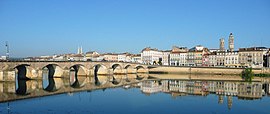Mâcon
| Mâcon | ||
|---|---|---|
 |
||
|
||
| Coordinates: 46°18′23″N 4°49′53″E / 46.30630°N 4.8313°ECoordinates: 46°18′23″N 4°49′53″E / 46.30630°N 4.8313°E | ||
| Country | France | |
| Region | Bourgogne-Franche-Comté | |
| Department | Saône-et-Loire | |
| Arrondissement | Mâcon | |
| Canton | Seat of 3 cantons (Mâcon-Centre, Mâcon-Nord and Mâcon-Sud) | |
| Intercommunality | Mâconnais–Val de Saône | |
| Government | ||
| • Mayor (2001–2014) | Jean-Patrick Courtois | |
| Area1 | 27.04 km2 (10.44 sq mi) | |
| Population (2006)2 | 35,393 | |
| • Density | 1,300/km2 (3,400/sq mi) | |
| Time zone | CET (UTC+1) | |
| • Summer (DST) | CEST (UTC+2) | |
| INSEE/Postal code | 71270 / 71000 | |
| Elevation | 167–347 m (548–1,138 ft) (avg. 175 m or 574 ft) |
|
| Website | Official website | |
|
1 French Land Register data, which excludes lakes, ponds, glaciers > 1 km² (0.386 sq mi or 247 acres) and river estuaries. 2Population without double counting: residents of multiple communes (e.g., students and military personnel) only counted once. |
||
1 French Land Register data, which excludes lakes, ponds, glaciers > 1 km² (0.386 sq mi or 247 acres) and river estuaries.
Mâcon (French pronunciation: [ma.kɔ̃]), historically anglicized as Mascon, is a small city in east-central France. It is the prefecture of the department of Saône-et-Loire in Bourgogne-Franche-Comté. Mâcon is home to over 35,000 residents, who are referred to in French as Mâconnais.
The city lies on the western bank of the Saône river, between Bresse in the east and the Beaujolais hills in the south. Mâcon is the southernmost city in the department of Saône-et-Loire and the region of Bourgogne-Franche-Comté. It is 65 kilometres (40 miles) north of Lyon and 400 kilometres (249 miles) from Paris.
The Saône river runs through the town. The climate is temperate with a slight continental tendency.
Mâcon features an oceanic climate (Koppen: Cfb), with hot and humid summers, slightly too cool to be called subtropical (Cfa). Winters are relatively cold to French standards, but milder and more rainy than north of Mâcon. Most precipitation is in spring and autumn.
The agglomeration of Mâcon originates from the establishment of an oppidum and of a river port by the Celts from the Aedui, probably at the beginning of the first century BC. Known then under the name of Matisco, the town developed significantly during the age of the Roman Empire. This is demonstrated by the large Roman hoard, the Mâcon Treasure, that was discovered in the town in 1764, the remains of which is in the British Museum. During the 4th century, the town was fortified.
...
Wikipedia



